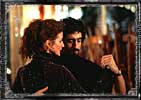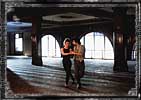|
In the early days men practiced together to perfect their moves before dancing with women, taking in turns to lead and follow. The dance of the "salons" (dancehalls) in Argentina was, and is, a close hold dance designed to be negotiated under crowded conditions. The couple appears to be completely absorbed in each other and in the music. It is essentially an improvised form in which the steps, swivels and turns are taken from an endless variety of permutations based on a basic vocabulary of moves.
As the tango became a form for the stage to be watched by audiences, the couple moved physically further apart from each other in order to become more visible and, with more space to move about in, the dance became more choreographically complex. A generation of dancers in the eighties, heavily influenced by the great teacher and dancer Todaro, evolved a spectacular style that audiences outside Argentina assume is the tango. The women are usually balletically trained with high leg extensions and the dance is fast, slick and athletic.

But Argentinians know this as "tango for export" and consider it too flashy by far for the salons. The overt sexuality described in many of the choreographies for the stage (along with their narratives based on clichés of the history of tango) bear little relation to the restrained subtlety of the best milongueros (salon dancers).
There is now also a third strand of tango dancing — mainly younger dancers who improvise in the salon and sometimes on stage and who borrow eclectically from both influences. They have the inventiveness and fire of the great jazz improvisers. Pablo Veron and Gustavo Naveira are amongst the best of these and combine an encyclopedic knowledge of the history and evolution of the dance with an irreverent willingness to push back its frontiers.

Ten years ago, the older milongueros feared that the tango would die out with them. But since then a second wave of tango fever has swept the world (the first was in the twenties). Now there are tango salons in every major European city and a constant influx from abroad of keen young tango students into Buenos Aires itself, which has helped to revive the tango. It is a dance that seems to inspire devotional fever; partly because of its endlessly rich and constantly evolving vocabulary of steps and partly because of its intimacy.
Sometimes slow, sometimes extraordinarily speedy, sometimes resembling a fight and sometimes danced with a beautiful tenderness — its wide expressive range also explains the huge current popularity of the tango.
|